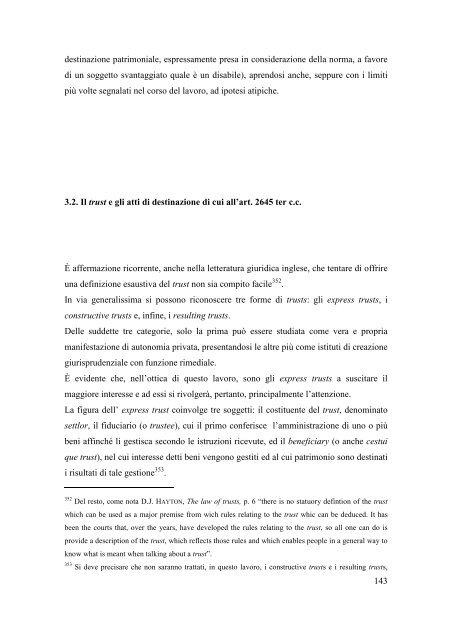“SEPARAZIONE PATRIMONIALE E AUTONOMIA PRIVATA”
“SEPARAZIONE PATRIMONIALE E AUTONOMIA PRIVATA”
“SEPARAZIONE PATRIMONIALE E AUTONOMIA PRIVATA”
Create successful ePaper yourself
Turn your PDF publications into a flip-book with our unique Google optimized e-Paper software.
destinazione patrimoniale, espressamente presa in considerazione della norma, a favore<br />
di un soggetto svantaggiato quale è un disabile), aprendosi anche, seppure con i limiti<br />
più volte segnalati nel corso del lavoro, ad ipotesi atipiche.<br />
3.2. Il trust e gli atti di destinazione di cui all’art. 2645 ter c.c.<br />
È affermazione ricorrente, anche nella letteratura giuridica inglese, che tentare di offrire<br />
una definizione esaustiva del trust non sia compito facile 352 .<br />
In via generalissima si possono riconoscere tre forme di trusts: gli express trusts, i<br />
constructive trusts e, infine, i resulting trusts.<br />
Delle suddette tre categorie, solo la prima può essere studiata come vera e propria<br />
manifestazione di autonomia privata, presentandosi le altre più come istituti di creazione<br />
giurisprudenziale con funzione rimediale.<br />
È evidente che, nell’ottica di questo lavoro, sono gli express trusts a suscitare il<br />
maggiore interesse e ad essi si rivolgerà, pertanto, principalmente l’attenzione.<br />
La figura dell’ express trust coinvolge tre soggetti: il costituente del trust, denominato<br />
settlor, il fiduciario (o trustee), cui il primo conferisce l’amministrazione di uno o più<br />
beni affinché li gestisca secondo le istruzioni ricevute, ed il beneficiary (o anche cestui<br />
que trust), nel cui interesse detti beni vengono gestiti ed al cui patrimonio sono destinati<br />
i risultati di tale gestione 353 .<br />
352 Del resto, come nota D.J. HAYTON, The law of trusts, p. 6 “there is no statuory defintion of the trust<br />
which can be used as a major premise from wich rules relating to the trust whic can be deduced. It has<br />
been the courts that, over the years, have developed the rules relating to the trust, so all one can do is<br />
provide a description of the trust, which reflects those rules and which enables people in a general way to<br />
know what is meant when talking about a trust”.<br />
353 Si deve precisare che non saranno trattati, in questo lavoro, i constructive trusts e i resulting trusts,<br />
143
















